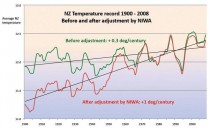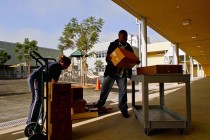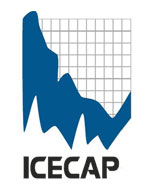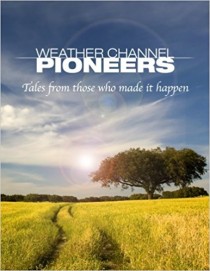ICSC
September 7, 2010: Critical Pacific Ocean subset of UN Intergovernmental Panel on Climate Change (IPCC) temperature data now to be examined by New Zealand High Court.
In what is believed to be the first case of its kind in the world, the newly formed New Zealand Climate Science Education Trust has taken legal action against the National Institute for Water and Atmospheric Research (NIWA), a ‘Crown Research Institute’ contracted by the NZ Government to be its sole adviser on scientific issues relating to climate change. Instead of using the New Zealand Met Service temperature record that shows no warming during the last century, NIWA has adopted an “adjusted” record of seven surface stations that shows a 1 deg. C rise, almost 50% above the global average for that period.

Enlarged here.
Because there are very few long term temperature records in the Pacific Ocean, the NIWA record bears heavily disproportionate weight in determining multi-decadal trends in global average temperatures used by the UN Intergovernmental Panel on Climate Change. However, the basis for the NIWA temperature adjustments is unknown, the data and calculations that underlie the adjustment method lost, and the originator of the technique of adjustment summarily dismissed from his position at NIWA.
Read news release from ICSC affiliate, the New Zealand Climate Science Coalition (NZCSC), which has unsuccessfully sought access to the data and calculations behind the temperature adjustment since 2006.
Read November 2009 NZCSC paper on the scandal, ”Are We Feeling Warmer Yet? ”, by Barry Brill, OBE.
Read May 2010 response to NIWA attempts to whitewash the affair.
Due to the international significance of this case, ICSC will keep readers up to date as this legal action unfolds. Read more on the NZCSC Home page.
See ICSC home page here.
By Howard Blume, Los Angeles Times
He’s the first vice president to have an L.A. school named after him, sharing the honor with author Rachel Carson. Fittingly, the campus will be devoted to environmental themes. But there’s a catch.
Al Gore has had some tough breaks - like losing the presidency after getting more votes than the other guy - but the noted environmentalist achieved a singular honor last week, becoming the first vice president to have a Los Angeles school named after him.
And, fittingly, the school will be devoted to environmental themes.

But as in the 2000 election, there’s a catch. Critics say the campus’ location poses a long-term health risk to students and staff. School district officials insist that the Arlington Heights property is clean and safe. And they’ve pledged to check vapor monitors and groundwater wells to make sure.
The $75.5-million Carson-Gore Academy of Environmental Sciences will open Sept. 13 for about 675 students. As he was with Bill Clinton (who has an L.A. middle school named after him), Gore is second on the ticket to Rachel Carson, the late author credited with helping launch the modern environmental movement.
“Renaming this terribly contaminated school after famous environmental advocates is an affront to the great work that these individuals have done to protect the public’s health from harm,” an environmental coalition wrote in a letter to the Los Angeles Unified School District. Making sure the school is safe “would be an even better way to honor their contribution to society.”
Construction crews were working at the campus up to the Labor Day weekend, replacing toxic soil with clean fill. All told, workers removed dirt from two 3,800-square-foot plots to a depth of 45 feet, space enough to hold a four-story building. The soil had contained more than a dozen underground storage tanks serving light industrial businesses.
Additional contamination may have come from the underground tanks of an adjacent gas station. A barrier will stretch 45 feet down from ground level to limit future possible fuel leakage.
An oil well operates across the street, but officials said they’ve found no associated risks. Like many local campuses, this school also sits above an oil field, but no oil field-related methane has been detected. Groundwater about 45 feet below the surface remains contaminated but also poses no risk, officials said.
Because the district imported clean dirt, the school is probably safe at the moment, said Jane Williams, executive director of the Kern County-based California Communities Against Toxics. But she and other critics, including Robina Suwol, who heads the locally based California Safe Schools coalition, worry that the pollution sources have not been adequately identified and that the dirty groundwater could recontaminate the soil.
Everything’s under control after the $4-million cleanup, said John Sterritt, the school system’s chief safety officer. “There’s no doubt in my mind that the site is safe, and if there are any changes, our monitoring or our existing processes will detect it and we’ll react to that,” Sterritt said. “We really go out of our way to make sure these properties are safe.”
Officials contend the district has made huge strides since environmental concerns stalled the Belmont Learning Complex, which has since opened as the Roybal Learning Center. In addition, new schools now fall under the review of the state Department of Toxic Substances Control.
In the spring, a school-naming committee received six options, including Pete Seeger Community School. A representative from school board member Marguerite Poindexter LaMotte suggested that the folk singer’s “affiliation with the Communist Party,” among other factors, made that choice inappropriate, two in attendance recalled.
Three meetings later, the consensus was Carson-Gore. At last week’s school board meeting, district officials said Gore had never been contacted regarding the naming or the contamination concerns. Board member Nury Martinez speculated that, under the circumstances, Gore might decline the honor.
But school Principal Kurt Lowry pointed out that no one obtained Barack Obama’s permission before naming a middle school (also opening this fall) after the president. Lowry intends to invite Gore and members of Carson’s family to the school’s October ribbon-cutting.
Gore is on vacation and unreachable, said spokesman Mike Feldman. But his staff is not aware of another school named after the former vice president, who raised awareness about global warming in the film “An Inconvenient Truth.” Lowry said the school’s environmental emphasis will do Gore proud, including recycling projects and research and beach cleanups. Cross-curriculum efforts will include environmental speeches and presentations in English, topsoil measurements in math and climate study in science.
The principal also envisions an organic garden that could produce a student-led farmer’s market. Suwol said Lowry sounds “incredibly wonderful,” but added that she’d feel better if the vegetables were grown in planters above the ground. See more here.
---------
Tale of Two Houses
House #1 A 20 room mansion (not including 8 bathrooms) heated by natural gas. Add on a pool (and a pool house) and a separate guest house, all heated by gas. In natural gas alone, this property consumes more than 20 times the national average for an American home. This house is not situated in a Northern or Midwestern “snow belt” area. It’s in the South.

House #2 Designed by an architecture professor at a leading national university. This house incorporates every “green” feature current home construction can provide. A central closet in the house holds ; geothermal heat-pumps drawing ground water through pipes sunk 300 feet into the ground. The water (usually 67 degrees F.) heats the house in the winter and cools it in the summer! The system uses no fossil fuels such as oil or natural gas and it consumes one-quarter of the electricity required for a conventional heating/cooling system.

#1 is outside of Nashville , Tennessee ; it is the abode of the “environmentalist” Al Gore.
#2 is on a ranch near Crawford, Texas ; it is the residence the of the last President of the United States , George W. Bush, reviled by environmentalists.
Climate Science Weblog
I have been interviewed by Hans von Storch for the August issue of the Atmospheric Sciences Section of the AGU Newsletter. The interview is reproduced below. Comments that have been made on the interview can be read on Hansís weblog Die Klimazwiebel.
Hans von Storch
Roger A. Pielke Sr. is currently a Senior Research Scientist at the Cooperative Institute for Research in Environmental Sciences (CIRES) at the University of Colorado and a Professor Emeritus of the Department of Atmospheric Science, Colorado State University. Pielke has studied weather and climate on local, regional and global scales using both models and observations throughout an over 40 year career. He has authored, co-authored and co-edited several books including “Mesoscale Meteorological Modeling” (1984; 2002), “The Hurricane” (1990), “Human Impacts on Weather and Climate” (1995; 2006), “Hurricanes: Their Nature and Impacts” (1997) and “Storms” (1999). Roger Pielke Sr. was elected a Fellow of the AMS in 1982 and a Fellow of the American Geophysical Union in 2004. He has served as Chief Editor of the Monthly Weather Review and Co-Chief Editor of the Journal of the Atmospheric Sciences. He is currently serving on the AGU Focus Group on Natural Hazards (August 2009-present) and the AMS Committee on Planned and Inadvertent Weather Modification (October 2009-present). Dr. Pielke has also published over 350 papers in peer-reviewed journals, 50 chapters in books, and made over 700 presentations during his career to date. A listing of papers can be viewed at the project website. He is among one of three faculty and one of four members listed by ISI HighlyCited in Geosciences at Colorado State University and the University of Colorado at Boulder, respectively.
Hans von Storch Question
Prof Pielke, you are an atmospheric scientist - what were the main scientific issues you have tackled in your long professional career?
Roger A. Pielke Sr. Reply
Our research team has investigated a wide range of climate processes. This includes studies in meteorology, hydrology, ecology and oceanography. Among our findings has been the clear demonstration of the close coupling between land surface processes and weather. I have also worked extensively to improve our understanding of the transport and dispersion of air pollution, as well as ways to reduce the risk from this environmental hazard.
Hans von Storch Question
How do you weigh the role and the potentials of models?
Roger A. Pielke Sr. Reply
Models are powerful tools with which to understand how the climate system works on multi-decadal time scale as long as there are observations to compare reality with the model simulations. However, when they are used for predictions of environmental and societal impacts decades from now in which there is no data to validate them, such as the IPCC predictions decades into the future, they present a level of forecast skill to policymakers that does not exist. These predictions are, in reality model sensitivity studies and as such this major limitation in their use as predictions needs to be emphasized. Unless accompanied by an adequate recognition of this large uncertainty they imply a confidence in the skill of the results that is not present.
Hans von Storch Question
You have become known for dissenting views in the present debate about the perspective of anthropogenic climate change. For example, you stress the role of land uses chances as another key driver in influencing our climate. Could you outline your position?
Roger A. Pielke Sr. Reply
My perspective is summarized in a recent publication with 18 other Fellows of the American Geophysical Union in an EOS article titled “Climate change: The need to consider human forcings besides greenhouse gases” [Pielke Sr. et al., 2009]. We wrote “the 2007 Intergovernmental Panel on Climate Change (IPCC) assessment did not sufficiently acknowledge the importance of these other human climate forcings in altering regional and global climate and their effects on predictability at the regional scale” and because “global climate models do not accurately simulate (or even include) several
of these other first order human climate forcings, policymakers must be made aware of the inability of the current generation of models to accurately forecast regional climate risks to resources on multidecadal time scales.”
Hans von Storch Question
If you were right, how would the range of options for response measures for limiting man-made climate change within certain bounds differ from what is commonly considered?
Roger A. Pielke Sr. Reply
We need to recognize that the IPCC starts from an inappropriately narrow perspective that the human input greenhouse gases is the dominate environmental concern in the coming decades and then the IPCC presents policymakers with a resulting broad range of expected regional and local impacts. This is, however, at best a flawed significantly, incomplete approach.
The IPCC process should be inverted. In our 2009 EOS article that I referred to above, we recommend that the next assessment phase of the IPCC (and other such assessments) broaden its perspective to include all of the human climate forcings. It should also adopt a complementary and precautionary resource based assessment of the vulnerability of critical resources (those affecting water, food, energy, and human and ecosystem health) to environmental variability and change of all types. This should include, but not be limited to, the effects due to all of the natural and human caused climate variations and changes.
After these threats are identified for each resource, then the relative risk from natural and human-caused climate change (estimated from the GCM projections, but also the historical, paleo-record, and worst case sequences of events) can be compared with other environmental and social risks in order to adopt the optimal mitigation/adaptation strategy.
The issues we should focus on can be summarized in this set of questions:
1. Why is this resource important? How is it used? To what stakeholders is it valuable?
2. What are the key environmental and social variables that influence this resource?
3. What is the sensitivity of this resource to changes in each of these key variables? (this includes, but is not limited to, the sensitivity of the resource to climate variations and change on short (e.g. days); medium (e.g. seasons) and long (e.g. multi-decadal) time scales.
4. What changes (thresholds) in these key variables would have to occur to result in a negative (or positive) response to this resource?
5. What are the best estimates of the probabilities for these changes to occur? What tools are available to quantify the effect of these changes. Can these estimates be skillfully predicted?
6. What actions (adaptation/mitigation) can be undertaken in order to minimize or eliminate the negative consequences of these changes (or to optimize a positive response)?
7. What are specific recommendations for policymakers and other stakeholders?
I have been commissioned as Chief Editor of a set of five books which will apply this bottom-up, resource based perspective.
Hans von Storch Question
You have retired a few years ago from your active duty as a professor at Colorado State University. Did retirement present for you a loss of opportunities, for instance with respect to teaching, or an opening of new possibilities?
Roger A. Pielke Sr. Reply
I continue to work with graduate students at the University of Colorado, and at other institutions including Purdue University and the University of Alabama at Huntsville. I continue to be active in research and mentoring of younger scientists.
Hans von Storch Question
What would you consider the two most significant achievements in your career?
Roger A. Pielke Sr. Reply
First, the opportunity to mentor graduate students and postdoctoral research staff, a number of who have become leaders in atmospheric and climate science has been an achievement I am proud of. Second, the perspective that climate is an integrated nonlinear physical, chemical and biological system, which requires the understanding of all components of the atmosphere, ocean, land and cryosphere, is starting to become more widely accepted. I have sought to promote this view over the last 20 year. This broader view of climate as a complex, nonlinear geophysical system is more scientifically robust than has been presented in the IPCC reports.
Hans von Storch Question
When you look back in time, what where the most significant, exciting or surprising developments in atmospheric science?
Roger A. Pielke Sr. Reply
The ability to monitor the climate system from space has provided a much better understanding of climate as a system. We also are developing an improved recognition of the difficult challenges we face in seeking to skillfully predict climate decades from now. In terms of negative developments, the bias in the funding of climate science research which tends to exclude perspectives that differ from the IPCC viewpoint is a major concern. Also, the introduction in the last 10-15 years of the publication in peer reviewed research papers of climate forecasts and impacts decades into the futures. Their publication subverts the scientific process since these predictions are not testable until after that time period has elapsed.
Hans von Storch Question
Is there a politicization of atmospheric science?
Roger A. Pielke Sr. Reply
Very definitely. There is a clear intent, for example, in the climate assessment report process to exclude scientists who disagree with the IPCC perspective from research papers and from funding. This was exemplified in the CRU e-mails, but it is a much wider problem as I have documented on my weblog, testimony to the U.S. Congress and in Public Comments.
Hans von Storch Question
What constitutes “good” science?
Roger A. Pielke Sr. Reply
“Good” science is completed when hypotheses are presented and tested with real world data to see if they can be refuted. Unfortunately, the IPCC uses multi-decadal global climate model predictions as a basis for policy action yet these model predictions cannot be tested since we need to wait decades to obtain the real world data. Even in hindcasts of the last few decades, these models have shown no regional predictive skill.
Hans von Storch Question
What is the subjective element in scientific practice? Does culture matter? What is the role of instinct?
Roger A. Pielke Sr. Reply
Science needs to advance by following the scientific method. This needs to be independent of culture or any other external influence.
Hans von Storch Closing Comment
For further reading about the opinions and views of Dr. Pielke Sr.’s refer to his blog.
References
Pielke, R., Sr., et al. (2009), Climate Change: The Need to Consider Human Forcings Besides Greenhouse Gases, Eos Trans.


